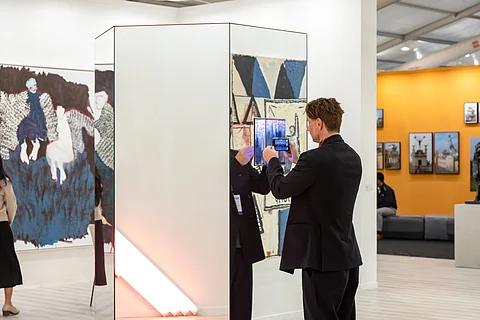
- Destinations
- Experiences
- Stay
- What's new
- Celebrating People
- Responsible Tourism
- CampaignsCampaigns
- SubscribeSubscribe
- Buy Now

Recently, a public service announcement was made from Indian Art Fair's instagram handle. It warned the common public that the gates would be closed at 2 pm and even the ticket holders wouldn't be guaranteed an entry. (A single ticket being worth INR 800). The reasons flagged for such abrupt closure were full capacity and government regulations and fire safety norms. So, if you have a ticket, you must queue up before 2 pm to ensure an entry. Such is the “overwhelming response” of the Indian Art Fair in its 16th edition.
The India Art Fair returned for its 16th edition from 6–9 February 2025 at the NSIC Exhibition Grounds, New Delhi. Touted as its most ambitious edition yet, this year's event boasts a record-breaking 120 exhibitors, including 78 galleries and numerous regional and international institutions. The fair promises to be a visual treat for art lovers, showcasing works by renowned modernists, contemporary giants and emerging talents from India and beyond.
The 16th edition of Indian Art Fair has been a curious litmus for the art scene in India which can now only be seen as burgeoning. Whether it is done in political abstraction or remains accessible to only a select few of the society is a question that gets dissipated in the hapless gatherings of visitors in its gargantuan exhibition halls, food stalls, beverage lot and other spaces. A trend—given that India is a country of chiefly youth population—that several young art collectors and some aspiring ones have come up on the Indian art scene is being observed. These new-age collectors are driven not just by investment prospects but by a genuine interest in contemporary art, often seeking to uplift the struggles of the artist and make art more fiscally more visible. This shift is seemingly redefining the Indian art market, infusing it with fresh energy and diversity; and thus, art is out there at NSIC grounds as if it were art’s own flea market.
The India Art Fair continues its mission to celebrate the best of South Asian art while welcoming an expanded international presence. Crucially, this year’s edition has remained so charitable as to give platform to emerging voices like T.V. Venkanna, Madhu Das, and Harsha Durugadda, who offer a fresh perspective, working across diverse mediums and reflecting contemporary India’s evolving narrative. However, the highlights also include new works by internationally acclaimed artists such as Anish Kapoor and Ai Weiwei, exhibited by Galleria Continua and Lisson Gallery. Additionally, Huma Bhabha and Oscar Murillo will unveil their latest creations with David Zwirner. In the market of art, Indian modernists like Ram Kumar, F.N. Souza, S.H. Raza, and M.F. Husain take centre stage through top galleries such as Chawla Art Gallery, DAG, and Archer Art Gallery.
Supported by JSW, the Growing Focus Talks Programme brings together leading voices from the art world, including curators, museum directors, and market specialists. Curiously, among the notable sessions are the BMW Art Talk featuring veteran artist Gulammohammed Sheikh and a panel discussion on the role of arts institutions with distinguished speakers like Tasneem Zakaria Mehta and Naomi Beckwith. These discussions, naturally, aim to explore the increasing prominence of South Asia in global contemporary art.
The outdoor installations at the India Art Fair 2025 are a testament to the innovative spirit of the participating artists. As soon as you enter, you’ll be confronted by a giant truck. Asim Waqif’s interactive installation, repurposing a second-hand cement truck, challenges perceptions of materiality and urban decay. Among others, you’ll find Claire Fontaine’s site-specific LED installation inspired by the Foreigners Everywhere series. Vibha Galhotra’s flag installation draws from Buddhist teachings to offer a message of hope and renewal. Ayesha Singh's IAF Facade, supported by MASH, celebrates women's contributions to Indian architecture, while Mohd. Intiyaz’s Dar Badar 2.0 evokes themes of resilience and belonging. These large-scale installations invite visitors, who are inclined, to engage deeply with their surroundings and reflect on contemporary social and environmental issues.
The fair’s Design section, curated by Alaiia Gujral, features 11 pioneering studios like RooshadSHROFF and Jaipur Rugs, showcasing hand-made collectible designs that represent South Asia’s vibrant design scene. Meanwhile, the Platform section highlights traditional South Asian art forms, offering a rich blend of heritage and modernity with contributions from organisations such as the Delhi Crafts Council and Gondwana Art Project.
Inclusivity takes centre stage with the Kiran Nadar Museum of Art (KNMA) as the Learning Partner, curating multilingual workshops for visitors of all abilities. Beyond the fairgrounds, New Delhi buzzes with parallel exhibitions at KNMA, Bikaner House, and the National Gallery of Modern Art, spotlighting modernism and emerging talent.
The Future is Born of Art Commission, in collaboration with BMW India, features Biolume, an immersive installation exploring bioluminescence and ecological balance. Fair Director Jaya Asokan calls this edition “a reflection of South Asia’s growing creative influence,” promising a truly memorable cultural experience.
